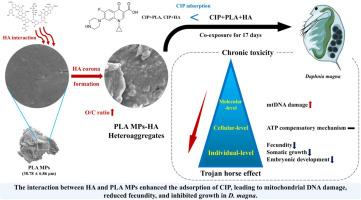Humic acid enhances adsorption of antibiotic ciprofloxacin on polylactic acid microplastics, leading to reproductive and mitochondrial toxicity in Daphnia magna: Quantitative analysis
IF 4.3
2区 环境科学与生态学
Q1 MARINE & FRESHWATER BIOLOGY
引用次数: 0
Abstract
Biodegradable microplastics (BMPs), which undergo incomplete degradation in freshwater environments, have emerged as potential vectors of micropollutants. However, their adsorption behavior and combined toxicity with coexisting micropollutants in the presence of natural organic matter (NOM) remain poorly understood. This study investigated the interaction of polylactic acid (PLA) microplastics (MPs)–humic acid (HA), adsorption of ciprofloxacin (CIP), and the combined toxicity to Daphnia magna exposed to PLA MPs, HA, and CIP for 17 days. PLA MPs interacted with HA to form heteroaggregates featuring an HA corona and a bridge-like structure, increasing the surface O/C ratio. HA initially suppressed CIP adsorption onto PLA MPs during the first hour, but significantly enhanced it after three hours, reaching 55.46 % equilibrium adsorption. Furthermore, combined exposure with HA exacerbated mitochondrial DNA damage in D. magna, while ATP levels remained stable due to a compensatory response. At the individual level, this exposure impaired reproduction, embryonic development, and somatic growth. Our findings suggest that BMPs, in the presence of NOM, enhance ecological toxicity through interactions with environmental pollutants, highlighting their emerging risks in freshwater ecosystems.

腐植酸增强抗生素环丙沙星在聚乳酸微塑料上的吸附,导致大水蚤的生殖和线粒体毒性:定量分析
生物可降解微塑料(BMPs)在淡水环境中不完全降解,已成为微污染物的潜在载体。然而,在天然有机物(NOM)存在的情况下,它们的吸附行为和与共存微污染物的联合毒性尚不清楚。研究了聚乳酸(PLA)微塑料(MPs)与腐植酸(HA)的相互作用、环丙沙星(CIP)的吸附以及暴露于聚乳酸(MPs)、HA和CIP 17 d后对大水蚤的联合毒性。PLA MPs与HA相互作用形成具有HA电晕和桥状结构的异质聚集体,增加了表面O/C比。HA在第一个小时内抑制了CIP在PLA MPs上的吸附,但在3小时后显著增强了CIP在PLA MPs上的吸附,达到55.46%的平衡吸附。此外,与HA联合暴露加重了D. magna线粒体DNA损伤,而ATP水平由于代偿反应保持稳定。在个体水平上,这种暴露损害了生殖、胚胎发育和体细胞生长。我们的研究结果表明,在存在NOM的情况下,bmp通过与环境污染物的相互作用增强了生态毒性,突出了它们在淡水生态系统中出现的风险。
本文章由计算机程序翻译,如有差异,请以英文原文为准。
求助全文
约1分钟内获得全文
求助全文
来源期刊

Aquatic Toxicology
环境科学-毒理学
CiteScore
7.10
自引率
4.40%
发文量
250
审稿时长
56 days
期刊介绍:
Aquatic Toxicology publishes significant contributions that increase the understanding of the impact of harmful substances (including natural and synthetic chemicals) on aquatic organisms and ecosystems.
Aquatic Toxicology considers both laboratory and field studies with a focus on marine/ freshwater environments. We strive to attract high quality original scientific papers, critical reviews and expert opinion papers in the following areas: Effects of harmful substances on molecular, cellular, sub-organismal, organismal, population, community, and ecosystem level; Toxic Mechanisms; Genetic disturbances, transgenerational effects, behavioral and adaptive responses; Impacts of harmful substances on structure, function of and services provided by aquatic ecosystems; Mixture toxicity assessment; Statistical approaches to predict exposure to and hazards of contaminants
The journal also considers manuscripts in other areas, such as the development of innovative concepts, approaches, and methodologies, which promote the wider application of toxicological datasets to the protection of aquatic environments and inform ecological risk assessments and decision making by relevant authorities.
 求助内容:
求助内容: 应助结果提醒方式:
应助结果提醒方式:


